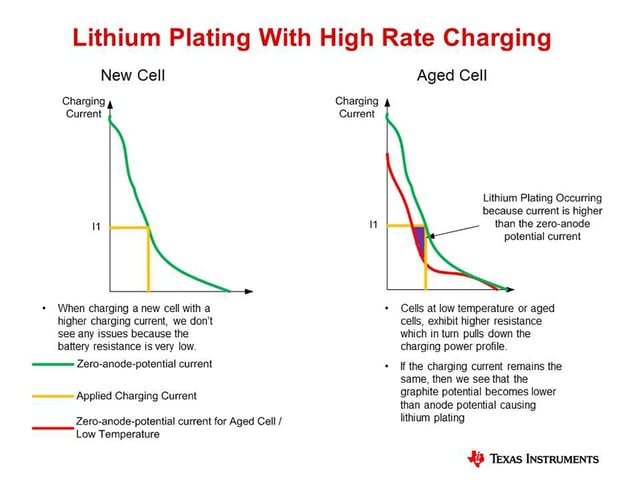Applications working in indoor and outdoor environments deal with fluctuating temperatures that impact how batteries operate. While batteries have wide operating ranges, working them at the extreme ends of their designated ranges can impact performance and battery life.
For charging and discharging batteries, these ranges differ from each other. Charging temperatures have an extremely limited range that differs between different types of battery chemistries.

* Image Source: www.TI.com/battery
Charging Problems at Extreme Temperatures
Most all battery chemistries will experience some type of damage when charging outside recommended temperature ranges. The type of damage may differ based on the specific materials used in the battery.
Cold Temperatures
People know that most electronics operating at room temperatures or cooler rooms with ventilation allow for the components to work at optimal levels. Yet even charging batteries have limits at sub-freezing temperatures.
Plating occurs in lithium-ion batteries while the electrolyte can freeze and crack the battery case for flooded lead acid batteries. When it comes to nickel-based chemistries, the temperatures cause issues with the hydrogen and oxygen combining. The building up of gases increases in pressure while the voltage drops as it may lead to venting.
Hot Temperatures
Heat impacts batteries in different ways as the more damage occurs the higher the temperature rises. Lithium-ion chemistries can handle an elevation in temperatures. However, keeping the battery charging for long periods at those higher temperatures may lead to gas generation and venting when going through excessive charging/recharging cycles. In addition, the longevity of the lithium-ion battery is impacted.
Nickel-based batteries undergo a circumstance where the heat tricks the charger into thinking that the battery is fully charged when it is not. This problem occurs due to the oxygen in the battery not being generated as much. With the lower oxygen level, the battery does not accept as much of a charge. So, charge acceptance becomes reduced at a rate that is based on the temperature. For example, if the temperature is at 113°F, then the battery may only charge up to 70% capacity.
The opposite holds true for flooded lead-acid batteries. When the temperatures rise, this battery charges faster, however, the battery readings will be tricked into showing that the battery isn't fully charged when it actually is. So, the battery may become overcharged. When a lead-acid battery becomes overcharged, the water that is within the electrolyte starts to decompose due to the excessive charge as the current flows through the battery. This problem leads to aging.
Discharging Problems at Extreme Temperatures
Batteries have the same cold temperature discharge threshold of -4°F no matter the chemistry. Hot temperature discharge rates only vary about 5°F for each battery. Discharging issues aren't as prominent for battery chemistries as they are for charging processes. However, there are things that customers need to be aware of when it comes to battery performance.
Cold Temperatures
If a battery is warm and then becomes introduced into a cold environment, a battery may still operate at an appropriate level. As the battery becomes colder, it experiences a higher internal resistance to the current. When in operation, the battery's capacity becomes reduced. So, a battery that would normally operate at 100% capacity at room temperature may only provide 50% capacity at temperatures of 0°F. Yet, keep in mind that as the battery works, it will heat up due to the internal resistance when the load is applied.
Some batteries can recover when they are reintroduced into a warmer environment. Also, battery life becomes extended in cooler temperatures. However, lead acid batteries will experience similar discharging problems as charging problems. The water in the electrolyte may freeze and cause damage.
Hot Temperatures
Hot temperatures are detrimental to battery life. Like cold temperatures, the battery rate becomes reduced significantly when the temperatures rise. A battery may only have its life cycle reduced by 20% at temperatures ranging from 104°F and 50% at 113°F.
Charging and Discharging Temperature Ranges
Battery manufacturers will provide specific battery temperature ranges for charging/discharging cycles for their specific products. Also, some lithium-ion manufacturers may design custom battery chemistries that allow for charging at lower levels than specified.
- Lithium-ion battery: Charge temperature at 32°F to 113°F; Discharge temperature at -4°F to 140°F
- Lead acid battery: Charge temperature at -4°F to 122°F; Discharge temperature at -4°F to 122°F
- Nickel-based battery: Charge temperature at 32°F to 113°F; Discharge temperature at -4°F to 149°F
A manufacturer must obtain certification that states that the lithium-ion battery can be charged below 32°F without causing lithium plating issues. A smart charger must also be designed that will monitor the battery’s current charge and keep the voltage as well as current at a safe limit. There are also other ways to charge batteries when dealing with colder and hotter temperatures.
- Lithium-ion batteries: A lithium-ion battery can undergo a fast charge at 41°F yet the charge rate should be lowered if under this temperature. No charging should ever be done to a lithium battery below freezing temperatures.
- Lead-acid batteries: A lead-acid battery should come with a smart charger that allows for voltage changes when sensing fluctuating temperature ranges. It should set the voltage higher when the battery is charged at lower temperatures and a lower voltage when charging at higher temperatures. The charge should be at 0.3C or less when the temperature is below freezing.
- Nickel-based batteries: A nickel-based battery can have a current charge reduced to 0.1C if temperatures are below freezing. Fast charging these batteries at fluctuating temperatures should only be done with chargers that have a thermal blanket designed into them or when the smart charger can automatically change its charge rate to account for differing temperatures.
Summary
Customers should always take environmental temperatures into consideration when selecting cell chemistries for custom battery packs. By informing the manufacturer regarding these factors, both the client and manufacturer may discuss charging and discharging solutions that best work with the application, battery pack, and charger. In many cases, a custom-design could offer an ideal alternative versus using a regular consumer off-the-shelf model.
Key Takeaways
- Charging at extreme temperatures can cause permanent damage: Charging batteries outside their recommended temperature range can lead to issues like lithium plating, gas buildup, venting, or even case cracking, especially in lithium-ion and lead-acid chemistries.
- Battery chemistry dictates ideal temperature ranges: Lithium-ion batteries typically charge best between 32°F and 113°F, while nickel-based and lead-acid chemistries have broader but still limited ranges. Charging below freezing is generally unsafe, especially for lithium-ion.
- Discharge rates and performance drop in cold environments: Cold temperatures raise internal resistance and reduce battery capacity. Some batteries may only deliver 50% of their rated capacity at 0°F. However, cooler conditions can help extend the overall battery lifespan.
- Heat shortens battery life and disrupts charging accuracy: High temperatures can reduce battery cycle life by up to 50% and cause inaccurate charge readings, leading to undercharging or overcharging, especially in nickel and lead-acid chemistries.
- Smart chargers are critical for temperature-sensitive applications: Chargers that monitor and adjust current and voltage based on temperature help protect battery health in extreme conditions. Some systems may require thermal management, like blankets or integrated sensors for safety.
















